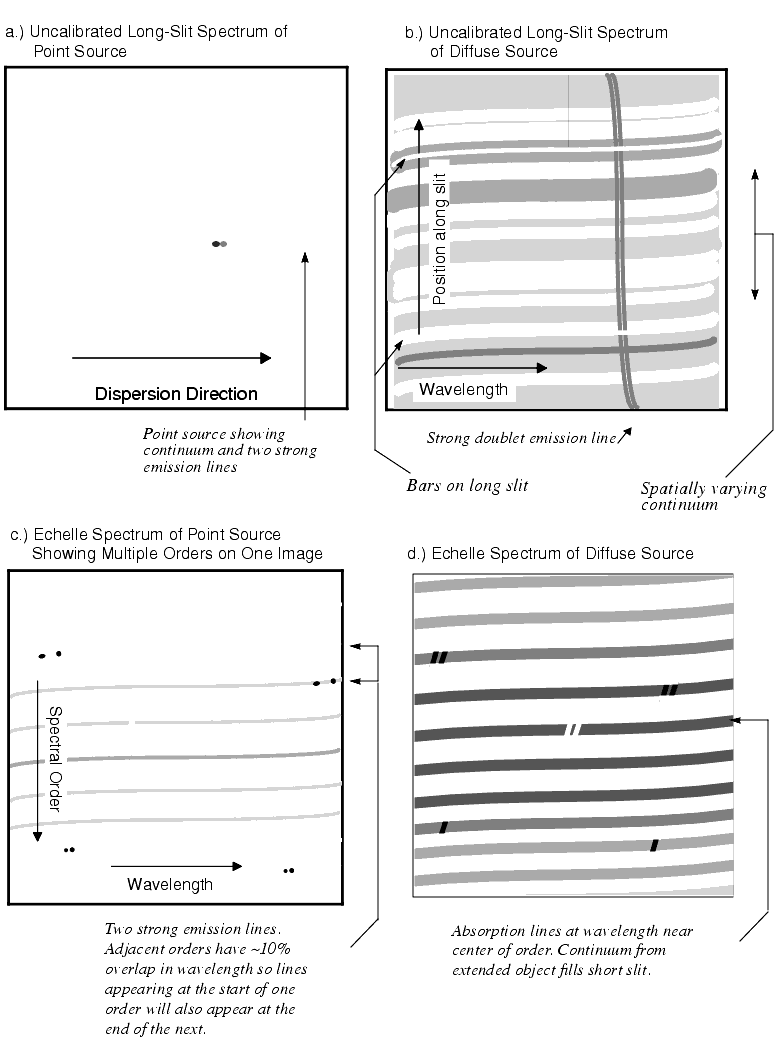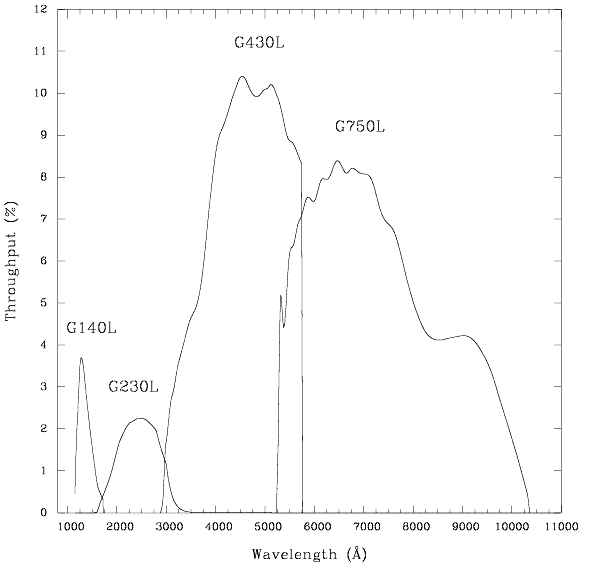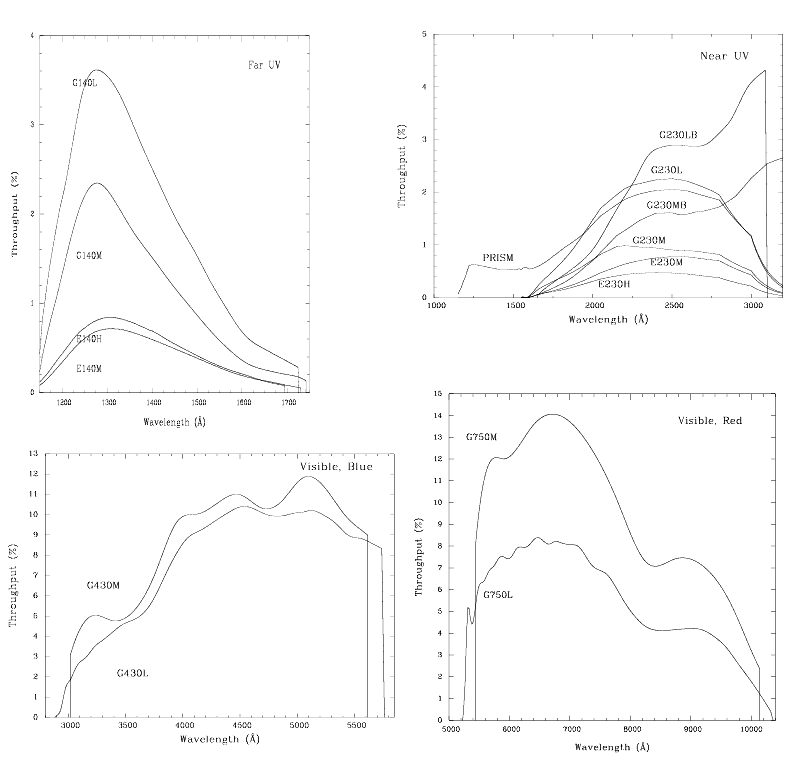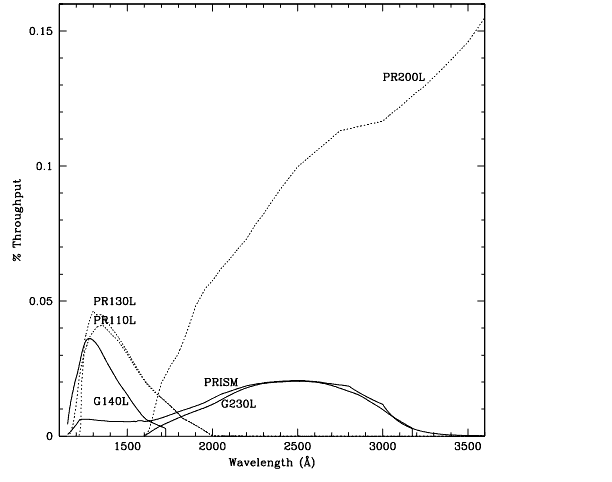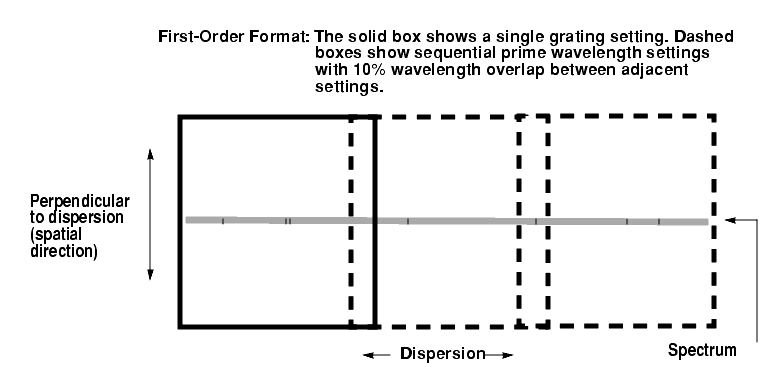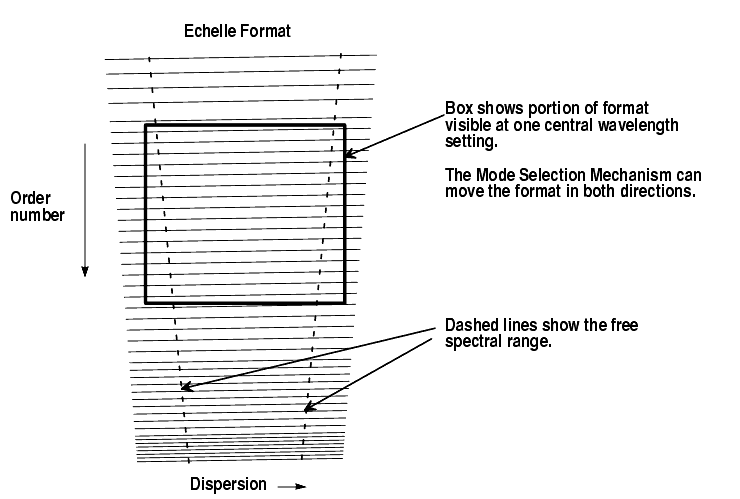


4.1 Overview
There are 15 spectroscopic modes which are summarized in Table 4.1 below. They comprise low and intermediate-resolution first-order modes designed to be used with a complement of long slits over the entire wavelength range, and intermediate and high-resolution echelle modes which have been optimized for point-source observations through short echelle slits and are available only in the ultraviolet (see Figure 4.2).
Table 4.1: STIS Spectroscopic Capabilities
|
|
Spectral Range (Å) |
Spectral Resolution |
|
|
|
|
|
|
| Grating |
Complete |
Per Tilt |
Scale   (Å per pixel) |
Resolving |
No. Prime |
Detector |
Reference material page |
Recommended Slits |
| MAMA First-Order Spectroscopy |
|
|
|
| G140L
|
1150-1730 |
610 |
0.60 |
960-1440 |
1 |
FUV-MAMA |
|
52X0.05D1 52X0.1D1 52X0.2D1 52X0.5D1 52X2D1 25MAMAD1 F25SRF2D1 F25QTZD1
|
|
52X0.05
52X0.1
52X0.2
52X0.5
52X2
52X2.2F1
0.2X0.2
|
| G140M
|
1140-1740 |
55 |
0.05 |
11,400-17,400 |
12 |
FUV-MAMA |
|
| G230L
|
1570-3180 |
1610 |
1.58 |
500-1010 |
1 |
NUV-MAMA |
|
|
| G230M
|
1640-3100 |
90 |
0.09 |
9110-17,220 |
18 |
NUV-MAMA |
|
|
| CCD First-Order Spectroscopy |
|
|
| G230LB
|
1680-3060 |
1380 |
1.35 |
620-1130 |
1 |
CCD |
|
|
52X0.05E1
52X0.1E1
52X0.2E1
52X0.5E1
52X2E1
|
| G230MB
|
1640-3190 |
155 |
0.15 |
5470-10,630 |
11 |
CCD |
|
|
| G430L
|
2900-5700 |
2800 |
2.73 |
530-1040 |
1 |
CCD |
|
|
| G430M
|
3020-5610 |
286 |
0.28 |
5390-10,020 |
10 |
CCD |
|
|
| G750L
G750M
|
5240-10,270 5450-10,140 |
5030 570 |
4.92 0.56 |
530-1040 4870-9050 |
1 9 |
CCD CCD |
|
52X0.2E2
52X0.5E2
52X2E2
|
| MAMA Echelle Spectroscopy |
|
|
|
| E140M
|
1150-1710 |
620 |
 /91,700 |
45,800 |
1 |
FUV-MAMA |
|
0.2X0.2, 0.2X0.06
|
| E140H
|
1150-1700 |
210 |
 /228,000 |
114,000 |
3 |
FUV-MAMA |
|
0.2X0.2, 0.2X0.09
|
| E230M
|
1570-3110 |
800 |
 /60,000 |
30,000 |
2 |
NUV-MAMA |
|
0.2X0.2, 0.2X0.06
|
| E230H
|
1620-3150 |
267 |
 /228,000 |
114,000 |
6 |
NUV-MAMA |
|
0.2X0.2, 0.2X0.09
|
| MAMA Prism Spectroscopy |
|
|
|
| PRISM
|
1150-3620 |
2470 |
0.2 - 72 |
2900 - 25 |
1 |
NUV-MAMA |
|
25MAMA, 52X0.05, 52x0.1,
52X0.2, 52X0.5, 52X2
|
1Number of exposures at distinct tilts needed to cover spectral range of grating with 10% wavelength overlap between adjacent settings.
2For a complete list of supported and available-but-unsupported apertures for each grating, see Table A.1.
3Naming convention gives dimensions of slit in arcseconds. E.g., 52X0.1 indicates the slit is 52 arcsec long perpendicular to the dispersion direction and 0.1 arcsec wide in the dispersion direction. The F (e.g., in 52X0.2F1) indicates a fiducial bar to be used for coronagraphic spectroscopy.
4For MAMA first-order modes, only ~ 25 arcsec of a long slit's length projects on the detector. (See also Section 4.2.2.).
5Full-aperture clear (50CCD or 25MAMA), longpass-filtered (F25QTZ or F25SRF2 in UV), and neutral-density-filtered slitless spectroscopy are also supported with the appropriate first-order and echelle gratings, as well as the PRISM.
6The following slits are also supported for all echelle gratings. The 6X0.2 and 52X0.05 long slits are intended for use with extended emission line objects; order overlap must be considered when using these slits. Also the high S/N multislits 0.2X0.2FP(A-E) and 0.2X0.06FP(A-E) (see Chapter 12), the very narrow 0.1X0.03 slit for maximum spectral resolution, and the 0.2X0.05ND and 0.3X0.05ND neutral density slits.
7The 0.1X0.09 and 0.1X0.2 slits are supported with E230H only. F25MGII is supported with all NUV-MAMA gratings and the PRISM.
8The 0.2X0.2 aperture is also supported with all first-order gratings. It is available-but-unsupported with the PRISM.
|
Table 4.2: Sample Uncalibrated Spectral Images (distortion is exaggerated)
4.1.1 Throughputs
To illustrate the broad wavelength coverage provided by STIS, and the relative throughputs achievable across STIS's wavelength regime, we show in Figure 4.1 the system throughput of the four low-resolution, first-order modes on a single plot (where the throughput is defined as the end-to-end effective area divided by the geometric area of a filled, unobstructed, 2.4 meter aperture). To allow you to judge the relative throughputs of different spectroscopic configurations, we plot in Figure 4.2: the efficiency of all grating modes for each of the four primary wavelength regimes on a common plot. These plots allow you to gauge the relative efficiencies of STIS in different configurations. Throughput changes in the first-order modes, determined from monitoring observations since STIS was installed, are discussed in Chapter 13.
Figure 4.1: System Throughput of STIS's Low-Resolution, First-Order Grating Modes
Figure 4.2: System Throughput of STIS's Grating Modes
4.1.2 STIS vs. ACS Spectroscopy
Optical wavelengths
Although ACS is primarily an imaging instrument, it has a few prisms and a grism which can be used for very low-resolution slitless spectroscopy. In the optical wavelength region of 5500 to 11,000 Å, ACS offers the G800L grism which can be used with either the WFC or the HRC. The resolving powers of the STIS gratings and the ACS grism are however very different: the resolving power of ACS G800L grism is 100 to 200, whereas the resolving power of the STIS gratings are 500 to 10,000. Their spectral coverage also differs. The entire wavelength range of 5500 to 11,000 Å is generally covered in a single exposure with the ACS G800L grism. With STIS, the spectral coverage depends on the grating used: with G750L it is possible to cover the entire wavelength range of 5240 to 10,200 Å in a single exposure, while a smaller spectral range at much higher dispersion can be obtained with the medium resolution M-gratings. Figure 4.3: shows a comparison of the transmissions of the ACS G800L grism and the STIS G750L grating. The ACS can be used only in slitless mode, so the spectral purity will be lower, and both source confusion and background contributions may be higher. These background differences must be correctly taken into account in any signal-to-noise estimates.
Figure 4.3: The total system throughput of the STIS CCD G750L configuration (solid line) is compared with that of the ACS WFC G800L (dotted line).
UV-wavelengths
In the ultraviolet, the ACS offers 3 prisms: PR200L with the HRC, and PR110L and PR130L with the SBC. Figure 4.4: shows a comparison of the transmissions of the ACS prisms and the STIS prism and low-resolution gratings. Note that the STIS prism uses the NUV-detector for the entire wavelength range; as a result the ACS prism has much higher sensitivities at FUV wavelengths. On the other hand, the STIS prism allows the entire wavelength range of 1150 to 3600 Å to be covered in a single exposure. Also, an appropriate slit can be used with the STIS prism whereas the ACS prism can be used only in slitless mode. While the ACS PR200L has a much higher throughput and wider spectral range than any of the STIS spectroscopic configurations, this comes at the price of a much lower dispersion, especially at the long wavelength end. Observers should carefully consult the ACS Instrument Handbook before choosing between STIS and ACS slitless spectroscopy.
Figure 4.4: The total system throughputs for the STIS G140L, G230L and NUV-PRISM modes (solid lines) are compared with the ACS SBC PR110L and PR150L and the ACS HRC PR200L prisms (dotted lines).
4.1.3 Limiting Magnitudes
In Table 4.3 below, we give the V magnitude for an A0V star that gives a signal-to-noise ratio of 10 in the continuum (per spectral resolution element around the peak of the grating response), in a 1 hour exposure, where we have integrated over the PSF in the direction perpendicular to the dispersion, and assumed the 52X0.2 slit for the first-order gratings and the 0.2X0.2 slit for the echelles.
Table 4.3: Limiting A0 V Star V Magnitudes
| Grating |
Wavelength (Å) |
Magnitude |
| G750L |
7000 |
20.9 |
| G750M |
7000 |
19.1 |
| G430L |
5500 |
20.9 |
| G430M |
5500 |
18.5 |
| G230LB |
3000 |
18.4 |
| G230MB |
3000 |
15.4 |
| G230L |
2600 |
18.4 |
| G230M |
2600 |
14.5 |
| G140L |
1350 |
16.7 |
| G140M |
1350 |
13.8 |
| E230M |
2700 |
13.5 |
| E230H |
2600 |
11.4 |
| E140M |
1400 |
11.4 |
| E140H |
1350 |
10.5 |
| PRISM |
|
20.1 @  = 2300 (slitless) |
4.1.4 Saturation
Both CCD and MAMA observations are subject to saturation at high total accumulated counts per pixel. The CCD can be saturated due to the saturation of the detector itself or of the gain amplifier for CCDGAIN=1. MAMA saturation can occur due to the 16-bit format of its memory buffer. The nature of the saturation for CCD and MAMA spectroscopic observations is described in Section 7.2.1 and Section 7.4.1, respectively.
4.1.5 MAMA Bright-Object Limits
The MAMA detectors are subject to:
- Absolute bright-object limits, above which targets cannot be observed.
- Science limits, above which the MAMA response becomes non-linear and photometric information is lost.
We direct MAMA observers to the discussion presented in Section 7.6. For summary tables of bright-object screening magnitudes for all spectroscopic modes, see Section 13.8. It is the observers' responsibility to be sure that proposed observations do not exceed the MAMA bright-object limits.
4.1.6 Scanned Gratings: Prime and Secondary (Tilt) Positions
For the intermediate-resolution gratings and echelles (except E140M), only a portion of the full spectral range of the grating falls on the detector in any one exposure, and the gratings must be scanned (tilted) with a separate exposure taken at each tilt position, in order to cover the full spectral range (see Figure 4.5 and Figure 4.6 below). Accordingly, for these scanned gratings, the user may select a single exposure at a given wavelength, or a series of exposures at different wavelengths to cover a larger wavelength range. The user must choose either prime or secondary settings. The prime settings cover the full spectral range with 10% wavelength overlap between observations taken at adjacent settings. The secondary settings cover selected absorption or emission lines and may be more convenient to use in some applications. We expect the photometric and wavelength calibration accuracies to be higher for the prime settings than for most of the secondary settings, as calibrations for the latter will be inferred from those taken at prime settings. A few frequently used secondary settings are being calibrated directly as noted in Chapter 13. The central wavelengths, and corresponding minimum and maximum wavelengths, are presented in the individual grating sections in Chapter 13.
Figure 4.5: Scanned First-Order Gratings
Figure 4.6: Scanned Echelle Gratings
4.1.7 Cross-Over Regions
In the near UV, where the CCD has comparable sensitivity to the NUV-MAMA, you may want to consider using the G230LB or G230MB gratings with the CCD instead of the G230L and G230M gratings with the MAMA. You will get improved throughput down to at least 2500 Å, a larger slit length, and use of the CCD rather than the MAMA (see Figure 4.2 and Chapter 13). On the other hand, the CCD has read noise, cosmic-ray sensitivity, hot pixels, and charge transfer efficiency losses. Also, for red objects, scattered light can be more of a problem with the red-sensitive CCD than with the solar-insensitive NUV-MAMA. For a solar-type spectrum, CCD data at wavelengths shorter than 2100 Å are dominated by scattered light.


Space Telescope Science Institute
http://www.stsci.edu
Voice: (410) 338-1082
help@stsci.edu
|


 /2
/2
 )
) /91,700
/91,700 /228,000
/228,000 /60,000
/60,000 /228,000
/228,000


